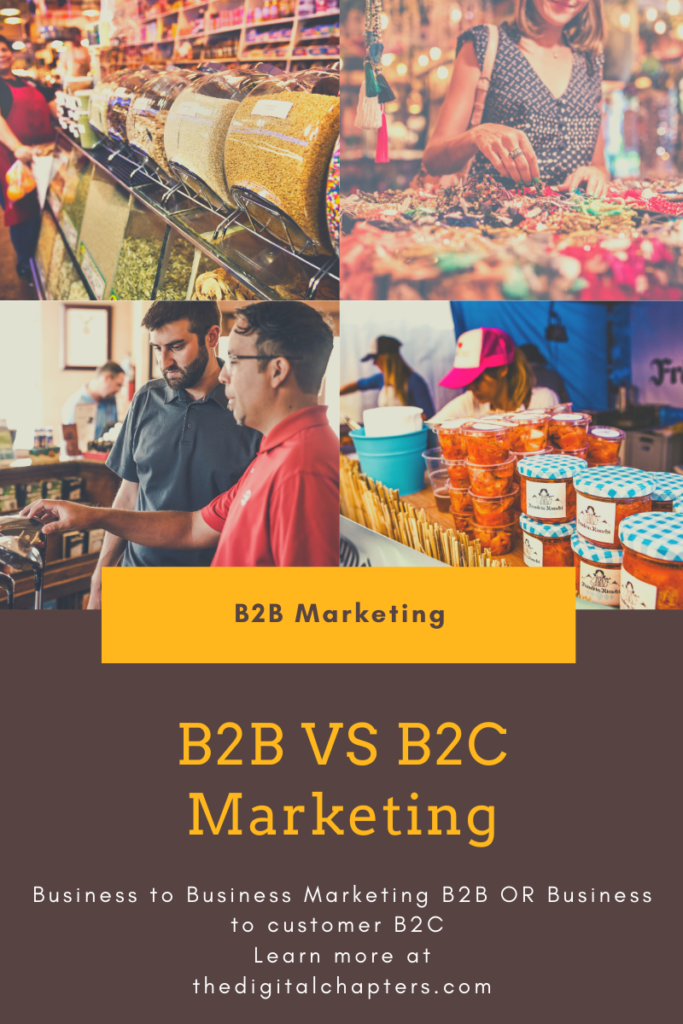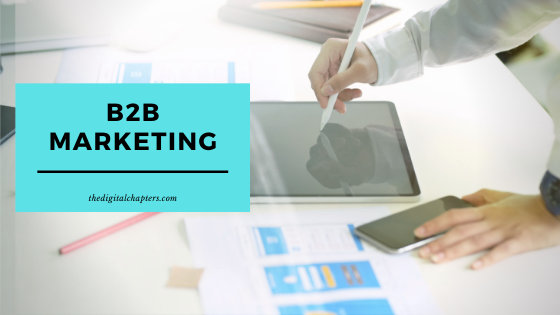B2B Marketing Strategies and Examples
Business to business Marketing, is also know as B2B Marketing is a process of Marketing where one organisation markets its products and services to other Organisation. It has several differences from Business to customer marketing or B2C.
Marketing is not easy to get right and is influenced by a lot of factors like budget constraints, creative decisions, and channel limitations amongst other factor.
However the single biggest factor to be taken into consideration while devising a market strategy or a plan is the end target audience.

The end target audience has a huge impact on the kind of the marketing campaign to be developed.
A marketing campaign developed for individual consumers is vastly different from the marketing campaign developed for organizations.
True to its name, Business to Business (B2B) marketing refers to the marketing of products or service by one organization to the other instead of the direct individual.
The sections below will elaborate the concept of B2B marketing in greater detail.
Table of Content
What is B2B Marketing
Features of B2B Marketing
How is B2B Marketing different from B2B Marketing
Examples of B2B Marketing
Devising B2B Marketing strategies
LinkedIn Based Strategies
Conclusion
1. What is B2B Marketing?
Unlike selling to individual organizations, B2B marketing deals with the marketing to products of services by one organization with the intention of selling those products or services commercially to other organizations.
While Business to Consumers (B2C) marketing is the one most visible over television and radio, the importance B2B transactions cannot to overestimate.
To put things in perspective, B2B markets account for almost 70% of the GDP of the United States, putting the annual size of B2B marketing in excess of US $ 10 trillion in USA alone.
Given the enormous size of the B2B market and the fact it outsizes the B2C market manifold, it is essential to have means and methods to specifically deal with this unique market.
1.1 Features of B2B Marketing
- In B2B marketing the decision is typically taken by a group of stakeholders instead of a single end user.
- The buying process in B2B is typically a longer and a more carefully deliberated process.
- In B2B transactions the financial factors like Return on Investment (ROI) assume critical importance.
- The information and product or service detailing is extremely critical component of B2B marketing.
- The B2B customers typically expect long term solutions instead of just momentary solutions.
1.2 Below are a few examples of B2B Marketing organizations
- Cisco Systems which develops networking hardware and telecommunication solutions for organizations.
- WeWork which provides shared workspaces and ancillary services for other companies.
- Tata Steel which sells steel products to other institutional organizations.
- B-Braun which sells medical equipment to hospital and other constitutional diagnostic centres.
1.3 B2B Marketers primarily focus on the following types of organizations
- Public sector or the government agencies (form the biggest customer base in B2B)
- Institutional customers like schools, hospitals, religious organizations, intelligence agencies, defence organizations amongst others.
- Bulk resellers and distributors like wholesalers and retailers
- The other organizations that are a direct logical customer.
2. How is B2B Marketing different from B2C Marketing
B2B and B2C are inherently different from each other. The applicable strategies to sell and the channels used differ in both the cases as the target audience is vastly different.
Let’s look at some of the critical differences.

Customer aim
- B2B: Focus on efficient product with focus on ROI
- B2C: Focus on fun, exciting deals
Purchase drivers
- B2B: Financial benefit and logic based
- B2C: Primary emotions
Decision making
- B2B: General a decision making committee or multiple people are involved in the decision making process
- B2C: Here end consumers normally make a unilateral decision without consulting others
Purpose
- B2B: Vision is more towards a long term solution
- B2C: Instantaneous solution and not necessarily long term driven
Process
- B2B: Longer sales process and cycle
- B2C: Must shorter sales process and cycle
3. Examples of B2B Marketing
As has been seen B2B marketing varies significantly from the B2C marketing both in terms of channels and strategy. Below are some of the examples of the B2B marketing
3.1 Technical and product blogs
One of the most critical means of B2B marketing are product blogs. Up-to date blogs provide a lot of visibility and are successful to attract enquiries or traffic to your online marketplace.
Combing written words with graphics and moving images create extremely effective blogs.
3.2 Webinars
Conducting technical webinars display a company`s competency and expertise in a specific product or service and are a great source of attracting traffic and generating leads for your business.
3.3 Optimizing SEO Practices
Efficiently optimising your online presence if of critical importance is today`s digital age. Search Engine Optimization technical are of prime importance.
Consider this. If someone searches for the term “Medical Devices”, a company like B-Braun would optimize its website and content in a manner that would be SEO efficient so that the B Braun website would be displayed as the first few results on searching of the term.
3.4 Email campaigns
E-mail campaigns are one of the oldest yet one of the most relevant methods of B2B marketing and is employed by over 90% of the marketers of B2B products.
Effective email campaigns contain product newsletters that succeed in generating leads and eventually get customers.
3.5 Technical papers and eBooks
Technical papers and eBooks on products, services, trends, innovation and other industry based knowhow are a great source to attract relevant industry based customers.
Access to the whitepapers could be controlled and made accessible once the one accessing the content provides contact details. This is an effective method for generating new leads.
3.6 Video content
Videos can be effectively used in conjunction with several other category types like technical blogs, webinars, and emails amongst others. With the growth of digital media, videos are becoming increasingly popular.
3.7 Social Media campaigns
With the promulgation of the internet and availability of high speed data at relatively cheaper costs, social media marketing is merging as “the go to” method of effective marketing.
Research says that over 75% of the decision makers in the B2B space use social media to decide on the purchase. Having web presence on popular social media sites is an effective way to build brand awareness and showcase your core competencies.
3.8 Case studies.
Case studies are an important form of B2B marketing.
Research has shown that case studies have amongst the highest conversion rates amongst different content types with over 75% if the decision makers using them in the B2B space.
Hence their usefulness cannot be overestimated.
4. 6 Devising B2B Marketing Strategies
As is the case for any successful marketing campaign, there are a few critical elements that one has to incorporate to make an efficient and effective campaign
4.1 Determine your market focus
It is extremely important to correctly t=identify your target market or else the marketing efforts will be wasted in targeted redundant and non-potential customers. Unlike B2C marketing, B2B marketing will not focus on mass markets. In effect creating the correct buyer persona is very important.
4.2 Analyse competition
A detailed competitor analysis an extremely critical step towards developing a successful strategy. Understanding the competitor core strength provides areas for your improvement and understanding their weakness gives areas where you can look to have a competitive advantages.
4.3 Determine the channels to be used
One the target market is identified and competition assessed, it is imperative to determine the means to reach your target audience.
The process of identification of the correct channel involves asking relevant questions pertaining to the industry and audience in terms of identifying the ways the prospects spend their time online, the queries they have, the events they attend and the social media networks they use.
4.4 Establish your web presence
In this day and age where everything is going digital any organization of repute must have an effective web presence. A majority of the buyers would look at your organization`s website as the first step towards gathering information about your organization.
4.5 Enumerate your goals
In order to have sharp focused strategy it is imperative to have identified and achievable goals which must be clearly mentioned. E.g. Increasing sales by 20%, increasing leads by 40% etc.
4.6 Measure, track and improve performance
This is a continuously running process which serves to identify how your campaign is progressing and serves to highlight any deviations/ anomalies. Depending upon the feedback from this steps one may need to tinker the content, channel or even the financial allocation.
5. 5 B2B LinkedIn Marketing Strategies
Research shows that LinkedIn has emerged as the most effective social media platform when it comes to B2B marketing. Almost all the B2B marketers these days have a presence on LinkedIn.
The reason is simple. LinkedIn as a platform connects multi-million professionals across the globe many of whom are in fact decision makers in the B2B space.
LinkedIn provides various products and services that are especially useful in the B2B space.
5.1 Sponsored Content
Also known as native ads, these appear in the form of highlights within the LinkedIn feeds and encourages traffic by pursuing members to visit.
5.2 Lead Generation
The premium lead generation tool is an effective way to populate a lead list as it uses an algorithm to identify leads based on a user’s profile information and data.
5.3 Retargeting Tool
This makes uses of cookies to enable organizations to keep a track of visitors to their page. This enable targeted marketing by focusing on “hot” leads and improving chances of final conversion.
5.4 Targeted emails
Via sponsored InMail feature, a company can directly reach the inboxes of professionals even if one if not connect to them. This helps broaden the net in terms of reaching more of the targeted audience.
5.5 Customized Ads
Also known as dynamic ads, these advertisements personalized for the end user and populates the content with relevant photos and video to create a more impactful effect.
Conclusion
The B2B is a massive market and dwarfs the B2C market. In today’s day and age an effective campaign is a must to achieve success in the segment primarily on account of the fickle nature of the customers in the segment.
In today`s information age, there is emphasis on digital marketing and any organization worth its salt is registering its significant presence there.
Social media hubs like Twitter and especially LinkedIn are emerging as preferred go to channels of marketing. These will continue to be significant channels of B2B marketing.

